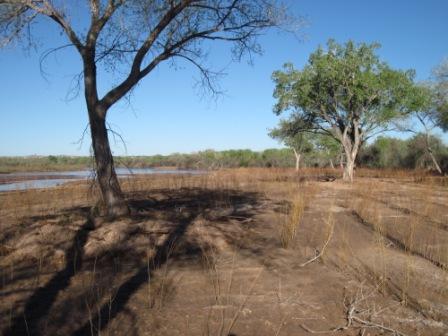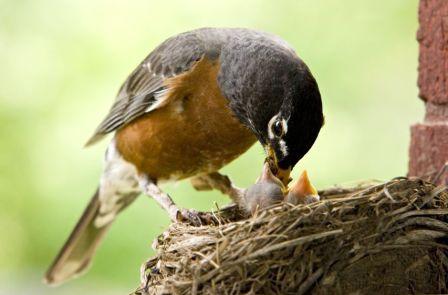
Don't Let This Happen to Your Dog!
Common porcupines (Erethizon dorsatum) live in the bosque, where they are often seen sleeping high in the limbs of cottonwood trees, especially once trees have lost their leaves. Slow-moving herbivores, porcupines are mostly active at night, in and among trees. Their favorite food is inner tree bark (cambium), tree fruits, nuts, seeds, leaves, shoots, and sprouts. When provoked, their normally flat quills stand up and are released on contact. (The quills are not “thrown,” but embed in whatever they touch.) Dogs often get “quilled” when porcupines are spending time on the ground seeking mates. Surprisingly, some dogs need more than one encounter to learn to stay away.

Quills must be removed, as they can slowly work their way into a dog’s body and even out the other side. Removal is painful because the quills are barbed, and if the dog has more than a few quills, they should be removed by a vet. Dogs have died of dehydration when their mouths were so filled with quills they could not swallow or salivate. That’s why it’s a good idea to keep dogs on leash in the bosque, especially in spring and summer.
Baby porcupines are cute as can be, until those quills harden.
Restoration Progress

As part of the U.S. Army Corps’ ongoing bosque restoration project, young willow trees have been planted in the bosque at the south end of Corrales. The project, approved by the Village on recommendation by the Corrales Bosque Advisory Commission, aims to transform “degraded” habitat—areas where invasive Russian olives and salt cedar grew back after clearing—with thousands of willows whips planted in shallow swales. The hope is that diverse plant species (including restored young cottonwoods) eventually will create wetland habitat that attracts wildlife and has less flammable vegetation.

For Coyotes, It’s Family First
By Susan Weiss
Coyotes live by family values. The commitment of each member to the family’s survival becomes obvious during breeding season. Howling is often heard in January and February, during courtship and mating of the alpha pair, as adults and yearlings encourage the couple to strengthen their relationship. In summer and fall, as the year’s cubs become more mobile, coyotes howl to call family members to gather at rendez-vous locations in the home range. This howling can be startling, especially when it wakens people from a deep sleep. Adult coyotes can be even more startling when they act to deflect perceived threats to their cubs.
Coyotes naturally defend their natal dens, but since they usually prepare these dens away from human activity, people are not likely to come across the cubs—except for curious children. As the cubs grow, however, and range farther from the den, the opportunity increases for people and their dogs to blunder into them.
If someone is walking their dog through the brush, a protective coyote parent might suddenly appear and growl or lunge. If a dog is moving along a path bordered with vegetation, it may be startled by a coyote executing a classic pattern. The coyote has seen the dog from a distance, and may track it, unnoticed. As the dog grows closer to the cubs, the coyote may chase the dog, or slip ahead and suddenly appear in front, confronting the dog. It might move slowly toward the dog, and even lunge and bite to protect its cubs.
That’s why, during cub season, it’s best to avoid walking in areas with poor visibility, especially with dogs. Remember that coyotes tend to give birth in less trafficked areas, and that cubs often wander into brushy and wooded areas where they may not be visible.
To prevent conflict with coyotes during cub season:
• Keep your dog on a leash. It’s the law in Corrales.
• Pay attention to your surroundings.
• If you notice a coyote following, challenging, or approaching, stop and pick up your dog, or pull it to you. Back away slowly while keeping watch, but do not make direct eye contact or run. If the coyote follows, shout, wave your arms, or throw pebbles.
• Find another walking route for a few months, in open areas with good visibility.
Many coyotes are not so protective. But whenever you encounter them, please give coyote parents a chance to raise their cubs as a family, in the wilder areas of their home range.

What to Do If You Find a Baby Bird
Return it to the nest and watch for up to two hours to be sure a parent returns to feed it. If not, or if you cannot find the nest, place the bird in a box filled with shredded tissue, and tape the lid shut. Place the box in a dark, quiet place, on thick toweling over a heating pad set to low (or half off the pad if the bird has even sparse feathers, rather than just a few wispy feathers or none). Immediately call one of the wildlife rescue facilities below for instructions.
If the bird is fully feathered and hopping strongly, put it in a safe location (such as under a shrub or on a low branch) while you wait for the parent to return. If the parent does not come in two hours, put the bird in a box as above, without the heating pad, and call wildlife rescue.
While waiting for bird parents, keep cats, dogs, roadrunners, hawks, and people away from
the baby bird. If you find a hummingbird, call wildlife rescue immediately.
Fur and Feathers: 505-898-6891 Wildlife Rescue hotline: 505-344-2500
